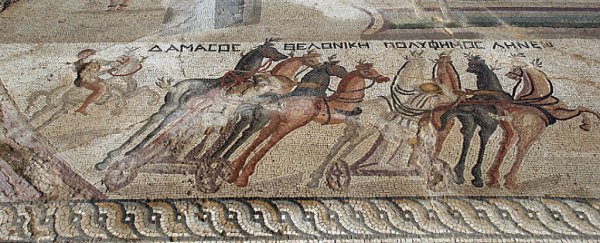A rare mosaic floor dated to the 4th century has been uncovered in Cyprus, the island that sits between the coasts of Syria and Turkey.
Decorated in scenes from an ancient chariot race being run inside a hippodrome - an ancient Grecian stadium - the mosaic is the first of its kind ever found in Cyprus, and is one of just a few such depictions discovered anywhere in the world.
"It is an extremely important finding, because of the technique and because of the theme," Cyprus's director of the Department of Antiquities, Marina Ieronymidou, told the press earlier this week.
"It is unique in Cyprus since the presence of this mosaic floor in a remote inland area provides important new information on that period in Cyprus and adds to our knowledge of the use of mosaic floors on the island."
The mosaic, which stretches 11 metres long and 4 metres wide (36 by 13 feet), has not yet been fully uncovered, but from what's been exposed so far, we can see four golden chariots, each being pulled by four horses.
Archaeologists have been able to make out certain characteristics representative of an ancient Greek hippodrome, and suggest that the scene is set in ancient Rome.
"The hippodrome was very important in ancient Roman times, it was the place where the emperor appeared to his people and projected his power," Cyprus Antiquities Department archaeologist Fryni Hadjichristofi told Menelaos Hadjicostis for the Associated Press.
While each of the teams is accompanied with an inscription that researchers suspect represent both the charioteer's name and the name of one of the horses, they're yet to be identified in existing historic records.
The mosaic also includes a depiction of what appears to be some kind of dolphin-shaped fountain, a figure holding a whip and one holding a water jug, and a single man on horseback.
Despite being more than 1,000 years old, the entire thing is remarkably well persevered.
According to Hadjichristofi, this is one of just seven such scenes found on mosaic floors from around the world, and confirms what archaeologists have long-suspected - there was some serious cash in Cyprus at the time.
Amazingly, the mosaic was discovered way back in 1938, by a farmer working in the Piadhia site of Akaki, a village in Cyprus's largest city, Nicosia. So why did it take archaeologists almost 80 years to unearth the thing?
Hadjichristofi told the AP that other finds had been prioritised, which really makes you stop and think about how much incredible archaeology the tiny island is harbouring.
While this artefact is certainly rare, and remarkable in its execution and preservation, it's certainly not the most hilarious ancient mosaic going around. That honour goes to the 2,400-year-old 'Reckless Skeleton' mosaic, recently excavated in the Hatay province on the Turkish-Syrian border, where the ancient Greek-Roman city of Antiocheia once thrived.
"Be cheerful, enjoy your life," the reclining skeleton advises us.
 Anadolu Agency
Anadolu Agency
And hey, who are we to refuse an ancient skeleton?
[Reclines furiously]
Here are some more pictures of the Cyprus chariot race:
 EPA
EPA
 EPA
EPA
 EPA
EPA
